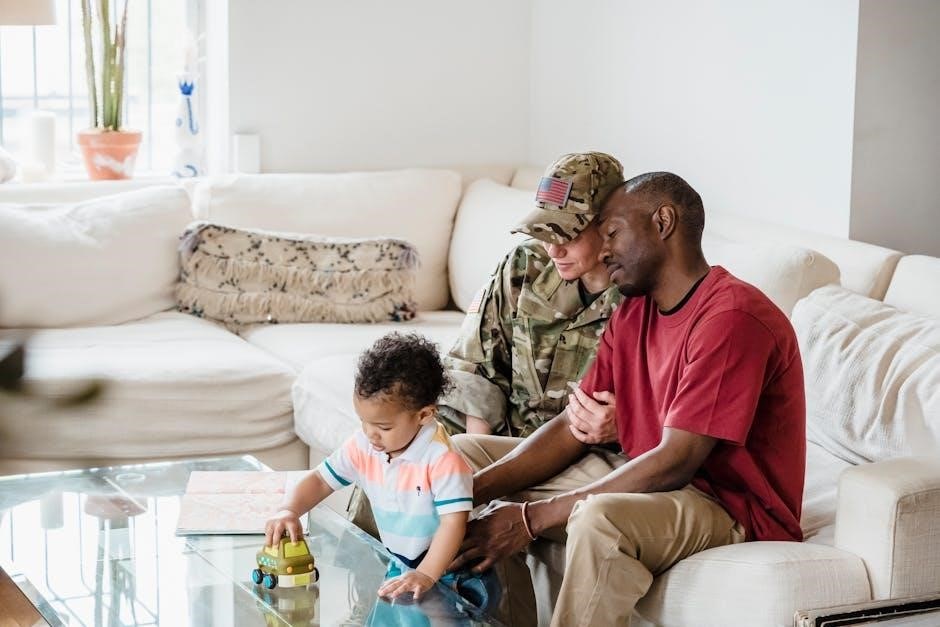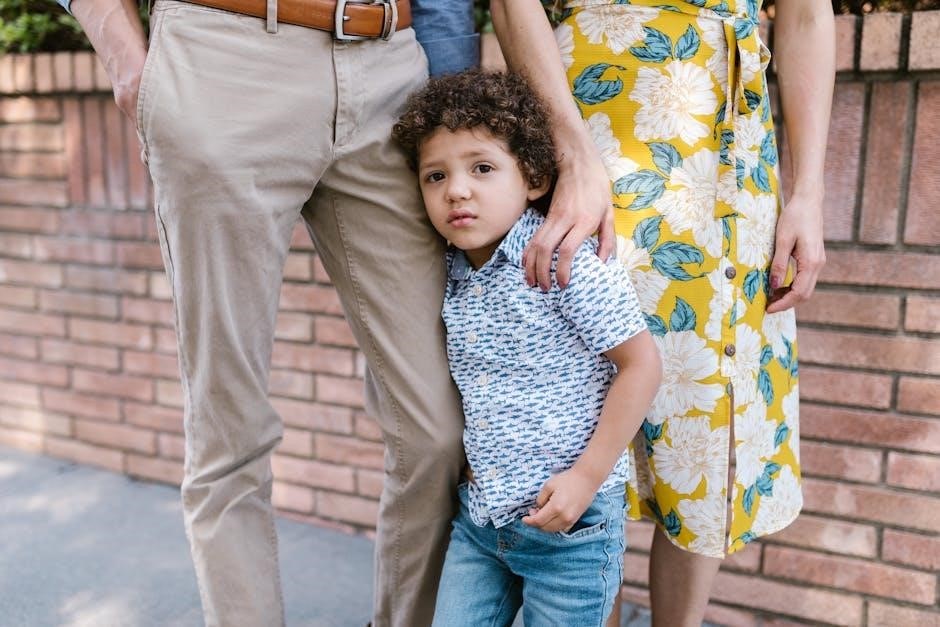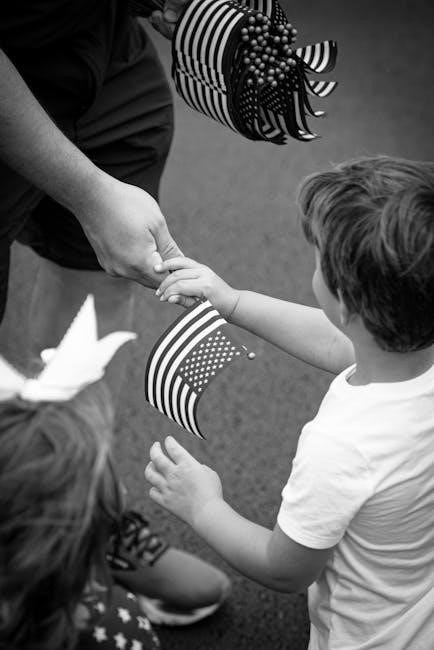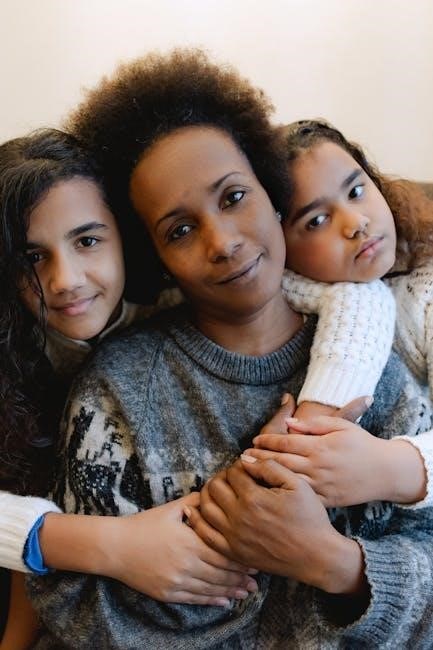A profound transformation in American family values has led to increased estrangement, driven by evolving gender roles, work-family conflicts, and changing societal expectations, reshaping family dynamics.
1.1 Historical Context: Evolution of Family Values in the U.S.
The evolution of American family values reflects broader societal changes. In the 19th and early 20th centuries, family structures were often hierarchical, with the father as the primary provider and the mother managing domestic duties.
The mid-20th century saw a rise in suburbanization and the idealization of the nuclear family, emphasizing unity and interdependence. However, the 1960s and 1970s ushered in cultural shifts, including the civil rights movement, feminism, and counterculture, which challenged traditional roles.
These changes laid the groundwork for modern family dynamics, where individualism and personal fulfillment gained prominence, sometimes leading to estrangement as expectations and values diverged.
1.2 The Role of Societal Norms in Shaping Family Dynamics
Societal norms have profoundly influenced American family dynamics, often dictating roles and expectations. Historically, norms emphasized unity and obedience, discouraging open conflict. However, as norms shifted toward individualism, families began prioritizing personal goals over collective harmony. This shift has led to increased estrangement, as differing expectations and values create tension. The pressure to conform to societal ideals, such as the “perfect family,” has also exacerbated conflicts, making it harder for families to navigate disagreements and maintain close relationships. These evolving norms continue to reshape family interactions and relationships.
The Rise of Estrangement in American Families
The rise of estrangement in American families reflects a growing trend of emotional disconnection, driven by shifting values and expectations. Families face increasing challenges.
2.1 Defining Estrangement and Its Prevalence

Estrangement refers to a state of emotional distance or conflict within families, often leading to physical or psychological separation. It is increasingly prevalent in American families, reflecting broader societal shifts. Studies suggest that approximately 40% of adults experience some form of estrangement, often due to unresolved conflicts or differing values. This phenomenon highlights the complexities of modern family dynamics, where changing expectations and individual priorities can create divides. Understanding its prevalence is crucial for addressing the emotional toll it takes on families and individuals alike.

2.2 Psychological and Emotional Impact on Families
Estrangement often leads to profound emotional distress, including feelings of guilt, anxiety, and depression. Family members may experience a deep sense of loss and isolation, even if the separation is perceived as necessary. The emotional distance can disrupt family dynamics, creating tension and misunderstanding. Additionally, estrangement can erode trust and communication, making it challenging to rebuild relationships. The psychological toll affects not only the individuals directly involved but also extended family members, highlighting the complex emotional landscape of modern familial conflicts and their lasting impact on mental well-being.

Key Drivers of the Shift in Family Values
Changing social norms, economic pressures, and technological advancements have reshaped family priorities, emphasizing individualism and personal goals over traditional roles, fueling estrangement and value mismatches.
3.1 Evolving Gender Roles and Their Effect on Family Relationships
Shifting gender roles have transformed family dynamics, as women increasingly pursue careers and men take on more domestic responsibilities. This shift challenges traditional expectations, creating tension and redefining relationship boundaries. The rise of dual-income households has led to balancing acts between work and family, often resulting in stress and conflict. Evolving roles also influence communication patterns, with modern families navigating new expectations and responsibilities. While these changes promote equality, they can also lead to misunderstandings and estrangement when roles are unclear or resisted.
3.2 Work-Family Conflicts and Changing Expectations
Work-family conflicts have intensified as dual-income households become the norm, leading to strained family relationships. Balancing professional demands with caregiving responsibilities creates stress, often resulting in emotional distance. Changing societal expectations around work commitment and family involvement further complicate dynamics. Parents may feel overwhelmed, reducing quality time with children and fostering resentment. These pressures can erode trust and intimacy, contributing to estrangement. The struggle to meet both work and family obligations underscores how modern expectations exacerbate conflicts within families.
3.3 Generational Differences and Their Role in Estrangement
Generational differences play a significant role in estrangement, as varying values and life experiences create divides. Baby Boomers often prioritize loyalty and obligation, while younger generations like Millennials and Gen Z emphasize personal growth and independence. These conflicting perspectives can lead to misunderstandings and emotional distance. Additionally, societal shifts, such as increased focus on individualism and changing views on family roles, exacerbate tensions. The gap between expectations and realities across generations further fuels estrangement, as families struggle to reconcile differing worldviews and priorities.

The Role of Personal Growth and Happiness
The pursuit of personal growth and happiness has become central to American family values, often leading to estrangement when individual goals clash with familial expectations and responsibilities.
4.1 How the Pursuit of Happiness Affects Family Relationships
The pursuit of personal happiness has reshaped American family values, often prioritizing individual fulfillment over collective family goals. This shift can lead to estrangement when family members feel their own aspirations are sidelined for others’ happiness. The emphasis on self-realization may create tension, as individuals assert their needs, sometimes at the expense of familial bonds. While this focus fosters personal growth, it can also strain relationships, highlighting the delicate balance between individual pursuit and family harmony in modern American society.
4.2 The Influence of Psychological and Emotional Well-Being
The growing emphasis on psychological and emotional well-being in American culture has profoundly impacted family dynamics. As individuals prioritize self-care and mental health, some family relationships may suffer if personal boundaries or needs are perceived as selfish. This shift can lead to estrangement when expectations of emotional support clash with individual pursuits of well-being. While focusing on mental health is vital, it can also create tension, highlighting the challenge of balancing personal emotional needs with familial responsibilities in an increasingly individualistic society.
The Impact of Divorce on Family Estrangement
Divorce often triggers estrangement by dividing loyalties, especially among children, and creating emotional distance. Financial stress and new family dynamics further exacerbate these challenges, deepening rifts.
5.1 How Divorce Increases the Risk of Estrangement
Divorce often creates emotional turmoil, leading to estrangement as family members struggle with loyalty conflicts and shifting dynamics. Children may feel forced to choose sides, causing long-term resentment. Communication breakdowns and unresolved conflicts further widen the gap. Financial stress and lifestyle changes can also fuel alienation, as families adapt to new realities. The loss of a united household can leave individuals feeling isolated, exacerbating feelings of estrangement; These factors collectively increase the likelihood of prolonged emotional distance and strained relationships within the family structure.
5.2 The Role of Loyalty and Obligation in Post-Divorce Families
Post-divorce, feelings of loyalty and obligation often create emotional challenges, particularly for children. They may feel torn between parents, leading to guilt or resentment. Societal expectations of loyalty can intensify these conflicts, as family members navigate new dynamics. Obligation to maintain relationships despite estrangement can strain bonds further. Additionally, shifting values around personal happiness versus traditional loyalty complicate reconciliation efforts, making it harder to rebuild trust and connection in fractured families. These emotional dilemmas highlight the complex interplay of loyalty and obligation in post-divorce estrangement.
The Role of Anxious Parenting
Anxious parenting, characterized by excessive concern and over-involvement, often leads to unintended pressure on children. This can create emotional distance, fostering estrangement as children seek independence from controlling behaviors.
6.1 Over-Involved Parenting and Its Consequences
Over-involved parenting, often termed “helicopter parenting,” has become a significant factor in family estrangement. Parents who excessively monitor, control, and intervene in their children’s lives can inadvertently create resentment. This behavior often stems from a desire to protect and ensure success but can undermine a child’s autonomy and confidence. Such dynamics may lead to emotional distance, as children feel suffocated or misunderstood. The pressure to meet parental expectations can foster conflict, ultimately driving a wedge between generations and contributing to estrangement.
- Undermines autonomy and independence.
- Creates emotional dependency or rebellion.
- Fosters resentment and long-term conflict.
6.2 How High Expectations Can Lead to Estrangement
High expectations within families often create pressure that can lead to estrangement. Parents may impose unrealistic standards on children, fostering feelings of inadequacy or resentment. When these expectations are not met, disappointment and conflict arise, straining relationships. Additionally, societal pressures to achieve academic, professional, or personal success can exacerbate tensions. The emotional gap widens as individuals feel misunderstood or unappreciated, leading to a breakdown in communication and trust. Managing expectations and fostering understanding becomes crucial to preventing such rifts.

The Role of Societal and Cultural Changes
7.1 The Decline of Extended Family Ties
Changing societal norms have weakened extended family bonds, reducing multigenerational support and increasing emotional distance among relatives.
7.2 The Impact of Increased Mobility and Dispersion
Greater geographic mobility has dispersed families, making regular interaction difficult and contributing to estrangement due to physical and emotional disconnection.
The decline of extended family ties has significantly contributed to the shift in American family values, fostering estrangement. Urbanization and increased mobility have led to physical distance between relatives, weakening traditional support systems. Additionally, the rise of nuclear families has reduced reliance on extended family networks, emphasizing individualism over collective responsibility. Cultural shifts, such as increased workforce participation among women, have further strained these ties. As a result, many families now struggle to maintain close-knit relationships, exacerbating feelings of isolation and disconnection across generations.
Increased mobility and dispersion have significantly contributed to the shift in American family values, leading to estrangement. As families move farther apart for work, education, or personal goals, physical distance weakens emotional bonds and shared experiences. The decline of close-knit communities means fewer opportunities for regular interaction, fostering a sense of isolation. While technology bridges some gaps, it often lacks the intimacy of in-person connections. This dispersion, combined with busy lifestyles, erodes the foundation of family relationships, making estrangement more likely. The loss of geographic closeness underscores the challenges of maintaining strong familial ties in modern America.
Case Studies and Real-Life Examples
Case studies reveal how shifting family values contribute to estrangement. One example involves a family where generational differences in work ethic led to emotional distance and eventual separation.
Another case highlights how changing views on gender roles created conflict between a traditional father and his progressive daughter, resulting in prolonged estrangement and unresolved tensions.
8.1 Stories of Estrangement and Their Underlying Causes
Stories of estrangement often reveal deep emotional wounds and shifting values. One example involves a young woman who pursued a career, conflicting with her traditional family’s expectations of marriage and childcare. Another case highlights a father and son divided by political ideologies, reflecting broader societal divisions. These narratives underscore how changing beliefs about personal freedom, identity, and responsibility can fracture relationships. Often, estrangement stems from unresolved conflicts, misunderstood expectations, or differing life choices, illustrating the complex interplay of individual and familial values.
8.2 How Families Navigate the Challenges of Estrangement
Families navigating estrangement often turn to mediation and therapy to address unresolved conflicts. Professional guidance helps facilitate open dialogue, fostering understanding and empathy. Setting clear boundaries can redefine family roles while respecting personal space. Encouraging honest communication and active listening rebuilds trust over time. Acknowledging past hurts without judgment allows for emotional healing; Time and patience are crucial, as reconciliation is rarely immediate. While not all relationships fully mend, these strategies can pave the way for mutual respect and closure, even if estrangement persists.

Expert Insights and Research Findings
Experts like Joshua Coleman and Stephanie Coontz offer insights into family estrangement, highlighting psychological and societal shifts. Coleman’s research emphasizes generational conflicts and emotional disconnection, while Coontz traces historical changes in family values.
Their findings underscore how evolving expectations and individualism contribute to estrangement, reshaping traditional family dynamics and creating new challenges for modern relationships.
9.1 Contributions of Psychologists Like Joshua Coleman
Psychologists like Joshua Coleman have provided insightful perspectives on family estrangement, emphasizing the emotional and relational complexities involved. Coleman’s work highlights how shifting family values, generational differences, and unrealistic expectations can lead to estrangement. He advocates for understanding the deeper psychological needs of individuals and fostering empathy in repairing relationships. His research underscores the importance of balancing personal autonomy with familial connections, offering practical strategies for healing and communication. Coleman’s contributions bridge the gap between theory and application, helping families navigate modern relational challenges.
9.2 Historical Perspectives from Stephanie Coontz and Steven Mintz
Stephanie Coontz and Steven Mintz provide critical historical perspectives on the evolution of American family values, offering insights into how societal changes have contributed to estrangement. Coontz, in her groundbreaking work The Way We Never Were, challenges the notion of a stable, traditional family structure, highlighting how shifting gender roles and economic pressures have reshaped family dynamics. Mintz, through his historical analysis, traces the impact of industrialization and urbanization on family relationships, revealing how these factors have eroded extended family ties and increased emotional distance. Their research underscores the long-term roots of modern estrangement.

Healing and Moving Forward

Healing and moving forward require open communication, empathy, and a willingness to address unresolved conflicts. Therapy and support groups can facilitate reconciliation, fostering personal growth and healthier relationships.
10.1 Strategies for Rebuilding Family Relationships
Rebuilding family relationships requires a combination of empathy, communication, and mutual effort. Active listening and acknowledging each other’s feelings can bridge emotional gaps. Setting healthy boundaries helps prevent future conflicts while fostering respect. Engaging in shared activities or rituals, like family dinners, can reignite connections. Seeking professional mediation, such as family therapy, provides a safe space for dialogue. Forgiveness and accountability are essential for healing past wounds. Small, consistent gestures of love and support can gradually rebuild trust and strengthen bonds over time.
10.2 The Importance of Empathy and Understanding
Empathy and understanding are crucial for healing strained family relationships. By actively listening to each other’s perspectives, family members can bridge emotional gaps and foster mutual respect. Understanding allows individuals to acknowledge each other’s experiences without judgment, creating a safe space for open communication. Empathy helps to validate feelings, which is essential for repairing trust and rebuilding connections. When families prioritize empathy, they can address conflicts more effectively and work toward reconciliation. This approach not only strengthens bonds but also promotes long-term emotional well-being and resilience.
The shift in American family values underscores a complex evolution, blending tradition with modern ideals, revealing both challenges and opportunities for relationships.
Ultimately, fostering empathy and understanding remains crucial, encouraging families to navigate change while balancing individual aspirations with enduring familial connections.
11.1 The Future of American Family Values and Estrangement
The future of American family values will likely see a continued emphasis on individualism and personal fulfillment, which may exacerbate estrangement trends. As societal expectations evolve, families may face increasing challenges in balancing independence with interdependence. The rise of chosen families and redefined kinship ties could become more prevalent, reflecting shifting cultural norms. Technology and globalization may further reshape family dynamics, creating both opportunities for connection and risks of isolation. Understanding these shifts will be crucial for fostering resilience and adaptability in modern families.
11.2 Final Thoughts on Navigating Modern Family Dynamics

Navigating modern family dynamics requires a balance of adaptability and empathy. As American family values evolve, understanding and respecting individual boundaries becomes crucial. Open communication and a willingness to compromise can bridge generational gaps and differing expectations. Families must embrace change while fostering resilience. By prioritizing emotional well-being and mutual respect, they can build stronger, more flexible relationships. Ultimately, recognizing that family dynamics are dynamic systems allows for growth and healing, even in the face of estrangement.
